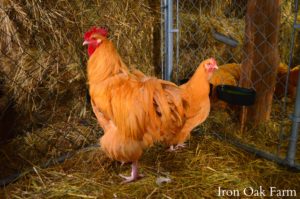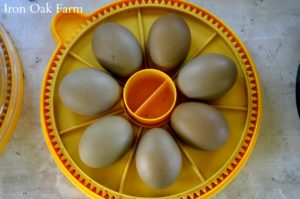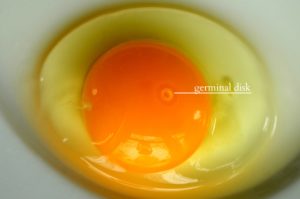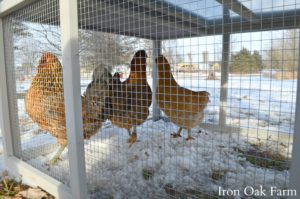 I have big plans for breeding chickens this spring. I finally have my show-quality, heritage breed Buff Orpingtons. We drove from Mid-Michigan to eastern Ohio last year to pick up two beautiful pairs of Buffs at the Ohio National Poultry show. I can’t wait to fill my incubator with eggs from these gorgeous birds!
I have big plans for breeding chickens this spring. I finally have my show-quality, heritage breed Buff Orpingtons. We drove from Mid-Michigan to eastern Ohio last year to pick up two beautiful pairs of Buffs at the Ohio National Poultry show. I can’t wait to fill my incubator with eggs from these gorgeous birds!
I also have plans to hatch out some more French Black Copper Marans, Leghorns and to cross-breed some Olive Eggers. Olive Eggers are a cross between a green laying breed like an Auracauna, or Ameracauna and a dark brown laying breed like a Maran or a Welsummer.
 In order for me to make the most of my breeding this year, there are a few things I plan on doing. I set up a breeding pen so that I can control which rooster I mate with which hens. Right now, much of the flock is mixed together so I have different breeds of roosters, potentially breeding with other breeds of hens.
In order for me to make the most of my breeding this year, there are a few things I plan on doing. I set up a breeding pen so that I can control which rooster I mate with which hens. Right now, much of the flock is mixed together so I have different breeds of roosters, potentially breeding with other breeds of hens.
We do not yet have the facility to separate each breed in individual pens. So I have to make do with what I can.
 I purchased this inexpensive, put-together coop to serve as our breeding/separation pen. It claims to house 8 standard size chickens but I think you’d be hard-pressed to comfortably house 8 chickens in this coop. Right now I have 3 hens and am thinking it’s going to be tight when I bring in the rooster. So at the moment, we are building an addition to the run to give the mating pairs a bit more room. Happy chickens lay the most eggs and that’s what I’m after.
I purchased this inexpensive, put-together coop to serve as our breeding/separation pen. It claims to house 8 standard size chickens but I think you’d be hard-pressed to comfortably house 8 chickens in this coop. Right now I have 3 hens and am thinking it’s going to be tight when I bring in the rooster. So at the moment, we are building an addition to the run to give the mating pairs a bit more room. Happy chickens lay the most eggs and that’s what I’m after.
My breeding practices start with identifying the chickens that I want to mate. This changes depending on the desired result I’m after in the offspring.
For example, right now I have some green laying Easter Eggers separated in the pen. They are my most saturated green layers. They also have the golden tones and the bearded muff that I like to see in my Olive Eggers. These offspring will most likely be charcoal, grayish-black. It’s a beautiful color.
 When they are “clean,” meaning all the sperm from other roosters has been flushed out of the hen’s system, I will introduce the desired rooster. In this case, one of our French Black Copper Marans.
When they are “clean,” meaning all the sperm from other roosters has been flushed out of the hen’s system, I will introduce the desired rooster. In this case, one of our French Black Copper Marans.
So how do I know when my hens are clean?
Well, a good guesstimate is around 10-14 days. Usually, around this time, the separated hens start laying unfertilized eggs.
But if you want to be sure, you can check for the germinal disc, or in this case, the lack of one.
When a hen lays an egg, if she is fertile, there will be a white spot on the egg yolk where the sperm entered the egg in the infundibulum.
How to read the germinal disc:
 When I start collecting eggs from my hens I crack them open to look for the germinal disc. (side note, these eggs are perfectly edible, the cells that become a chick do not start dividing until the egg has been under constant incubation for at least 48 hours. So once you crack them, feel free to fry them up for breakfast.)
When I start collecting eggs from my hens I crack them open to look for the germinal disc. (side note, these eggs are perfectly edible, the cells that become a chick do not start dividing until the egg has been under constant incubation for at least 48 hours. So once you crack them, feel free to fry them up for breakfast.)
If the germinal disc is present, I know these hens are still carrying sperm from an undesired rooster. If I collect and incubate these eggs, they will develop into chicks from that rooster.
Each day I check the eggs. Once the hen has laid 3 days of clean eggs (where the disk is not present) I consider her “clean”.
I then introduce the rooster I want her to mate with.
Once the rooster is introduced, I then start checking eggs to see if his insemination is taking hold. I want to see the germinal disk once more with this new rooster’s sperm.
This practice checks the fertility of the rooster, and also shows if he is mating successfully with these hens. Sometimes roosters may be appearing to mate, but physical factors like too much plumage around the rear can affect success.
You may be asking:

Why don’t I just put the rooster in with the hens I want to breed right away?

There are two reasons I don’t do this:
- Unless I wait at least 2 weeks, I won’t know if the germinal disks I’m seeing are from the old rooster or the newly introduced one.
- I don’t like to separate my roosters in the breeding pen for too long because I run the risk of them becoming unsocialized from the original flock. This can make reintroduction impossible, as the other roosters in the flock see their old friend as a new threatening male and can result in fighting.
On a side note, I have read that with the introduction of a new male, it can help to drive out the sperm from other males quicker. But because there is no foolproof way to check this other than the long amounts of time, I prefer to use the germinal disk check.
In the end, the germinal disk saves me from having to set up incubators and waiting for chick development (through candling) to see if the egg was fertile. If the hen is laying a constant stream of fertile eggs, then chances are, most of the eggs she lays will be fertile.












